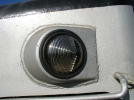| Until
the latter part of the 1900's, most all locomotives produced in the
U.S. had class (classification) lights. The purpose of the
lights was to display information about the train that the locomotive
was attached to. The lights were capable of displaying 3 colors,
white, red and green. The white light meant "extra", that is a
train which is not running on a timetable schedule. The red light
would be displayed on the rear end of a locomotive, sort of like a red
tail light on a automobile. Typically, this would only be seen
when the locomotive was running by itself or being used as a pusher
(helper) on a train. The green light was used to indicate that
the train was a "section" of a train. If train 98 was sold out
and the SP had to add an additional section, the locomotive on the
leading section would have green class lights and the second train's
class lights would be turned off. If there were more than two
sections, all but the last section would display green in the class
lights. Class lights were normally illuminated only on the end of
the locomotive facing the front of the train, the red lights being the
exception. The 3 different colors were easily achieved by having
a clear lens facing outwards on the locomotive and 2 glass plates, one
green and one red that could be put in a holder located between the
bulb and the lens. The front class lights on the 4423 were basically intact but badly rusted and had been disconnected so the class light circuit could be used for front ditch lights. They also needed new rubber moulding for the lens. The rear class lights were completely missing and the holes plated over. The rear class lights on an SD9 are preculiar in that they open from the outside for bulb replacement and lens changing. In addition, the entire light assembly can be removed for access to the upper radiator pipe connections. As far as I can determine, only the SD9 and SD24 used this arrangement. Click on any thumbnail
for a larger image. Use your browsers "back" button to get back
here.
|
Rear
 |
 |
 |
Front
 |
 |
 |
 |
 |
 |
 |